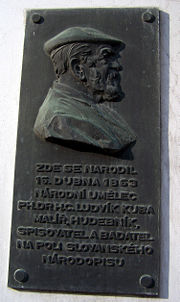
Ludvík Kuba
Encyclopedia

Landscape
Landscape comprises the visible features of an area of land, including the physical elements of landforms such as mountains, hills, water bodies such as rivers, lakes, ponds and the sea, living elements of land cover including indigenous vegetation, human elements including different forms of...
painter, musician, writer, professor in the Academy of Fine Arts. He was a representative of the Late-Impressionism
Impressionism
Impressionism was a 19th-century art movement that originated with a group of Paris-based artists whose independent exhibitions brought them to prominence during the 1870s and 1880s...
and he collected folk traditions.
Life
Ludvík Kuba studied to play the organOrgan (music)
The organ , is a keyboard instrument of one or more divisions, each played with its own keyboard operated either with the hands or with the feet. The organ is a relatively old musical instrument in the Western musical tradition, dating from the time of Ctesibius of Alexandria who is credited with...
and privately learnt drawing at Bohuslav Schnirch
Bohuslav Schnirch
Bohuslav Schnirch , was a Czech sculptor perhaps best known for his architectural sculpture. Schnirch sculpted 10 of the 20 roof statues, and the interior sculpted pediment, on Josef Zítek's 1881 National Theatre ....
and Karel Liebscher. He was accepted to the Academy of Fine Arts and educated in the studio of Max Pirner (1891-93). Then he studied at Académie Julian
Académie Julian
The Académie Julian was an art school in Paris, France.Rodolphe Julian established the Académie Julian in 1868 at the Passage des Panoramas, as a private studio school for art students. The Académie Julian not only prepared students to the exams at the prestigious École des Beaux-Arts, but offered...
in Paris
Paris
Paris is the capital and largest city in France, situated on the river Seine, in northern France, at the heart of the Île-de-France region...
(1893-95) and the school of Anton Ažbe
Anton Ažbe
Anton Ažbe was a Slovene realist painter and teacher of painting.Ažbe, crippled since birth and orphaned at the age of 8, learned painting as an apprentice to Janez Wolf and at the Academies in Vienna and Munich. At the age of 30 Ažbe founded his own school of painting in Munich that became a...
in Munich
Munich
Munich The city's motto is "" . Before 2006, it was "Weltstadt mit Herz" . Its native name, , is derived from the Old High German Munichen, meaning "by the monks' place". The city's name derives from the monks of the Benedictine order who founded the city; hence the monk depicted on the city's coat...
(1895-1904). He then devoted his life to painting, collecting folk songs (e.g. Slovanstvo ve svých písních - "Slavonic peoples in their songs" recorded 4000 songs) and writing about folk traditions. His artistic style was highly marked with Impressionism and he mainly painted landscapes (his favourite was South Bohemia), portraits (e.g. Josef Svatopluk Machar
Josef Svatopluk Machar
Josef Svatopluk Machar was a Czech poet and essayist. A a leader of the realist movement in Czech poetry and a master of colloquial Czech, Machar was active in anti-Austrian political circles in Vienna. Many of his poems were satires of political and social conditions...
) and still-lifes (e.g. Red Begonias). He was awarded a lot of Czech and international prizes.
Travels
He traveled through the Balkans, observed local Slavic cultures and wrote in detail about the local customs, history and feeling of the people. Memorable works include travels through MacedoniaMacedonia (region)
Macedonia is a geographical and historical region of the Balkan peninsula in southeastern Europe. Its boundaries have changed considerably over time, but nowadays the region is considered to include parts of five Balkan countries: Greece, the Republic of Macedonia, Bulgaria, Albania, Serbia, as...
in Book about Macedonia (1925-1927) and Songs from Bosnia and Herzegovina.

